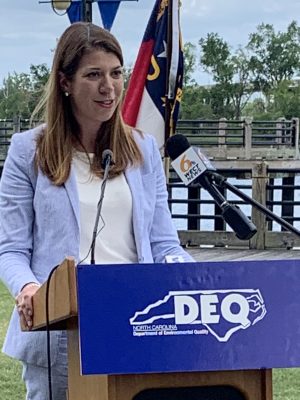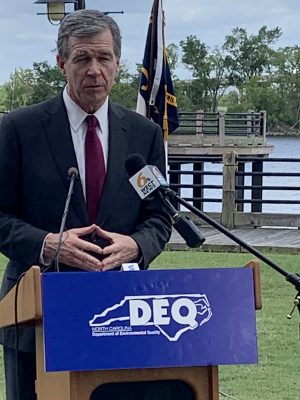
Fourth in a series.
WILMINGTON – When construction wraps at Cape Fear Public Utility Authority’s Sweeney Water Treatment Plant this summer, almost 3 million pounds of carbon will be in place to remove chemical compounds contaminating water pumped from the Cape Fear River and to the homes of tens of thousands of the utility’s customers.
Supporter Spotlight
The addition of the granular activated carbon, or GAC, system is expected to filter out on average 90% of per- and polyfluoroalkyl substances, or PFAS, from water sucked out of the river about 24 miles upstream from the plant at the Kings Bluff Raw Water Pump Station in Bladen County.
Sweeney’s existing filtration system, which includes 14 biological filters that contain GAC, removes about 35% of PFAS from raw, untreated Cape Fear River water, according to Carel Vandermeyden, the utility’s deputy executive director for treatment and engineering.
During a tour of the $43 million plant addition last month, Vandermeyden talked about the challenges the utility has faced since learning the water it’s been supplying to customers since it began operations in 2008 has been contaminated by chemical compounds discharged for decades from a manufacturing company upstream.
“We had already invested in our plant in the past. We already had the best technology here. We just didn’t have the PFAS removal.”
The Sweeney plant sits just off the river banks in downtown Wilmington on a sprawling piece of land dotted by an office building, parking lot, tanks that handle residuals left from the treatment process, and buildings that hold the plant operating room and existing filtration system.
Supporter Spotlight
A square-shaped grassy lot along the backside of a building where a series of large, color-coded pipes move water through the treatment process was practically the only space available for the brick and mortar expansion.

On a cool, mid-May day, construction workers bustled inside the space of concrete and pipe where the eight GAC filters are being installed.
Gravel from wheelbarrows was fed down a pipe running down a wall of one of eight large, square cement compartments. Hard-hat-clad workers in the bottom of the compartment evenly raked the gravel along a floor that consists of a perforated plastic underdrain system that collects the filtered water.
Water pumped into the GAC filters will enter at the top, then flow through 12.5 feet of carbon atop 14 inches of gravel. The filtered water will then be collected on the bottom in the underdrain system.
Each filter compartment will contain nearly 370,000 pounds of GAC capable of treating about 5.5 million gallons of water per day.
Vandermeyden said the plant will likely operate five or six GAC filters at a time. One will remain on standby and one will be the spare, used when carbon needs to be replaced in another filter.
“That’s going to be one of the more expensive and maintenance-intense aspects,” he said.
Each filter is expected to run between 250 to 300 days before the carbon in them needs to be replaced, a process that requires the old carbon be vacuumed out before a fresh batch is trucked in.
CFPUA has budgeted $3.7 million this coming fiscal year, which starts July 1, for carbon replacement. The process is expected to cost about $5 million a year in subsequent years.
GAC has been around since the early 1990s, a proven technology that’s been well researched, Vandermeyden said.
CFPUA officials determined this filtration system was the better fit for the utility over reverse osmosis, or RO, a system the public utility in neighboring Brunswick County opted for to remove PFAS.
Brunswick County was in the midst of a multi-year, three-phase expansion of its Northwest Water Treatment Plant in response to growing demand and the population boom there when news first broke about PFAS contamination in the river.
In early 2018, the Brunswick County Board of Commissioners voted to install an advanced low-pressure reverse osmosis system in the last phase of the plant expansion project.
The county hired an engineering and consulting firm to conduct a pilot low-pressure RO testing program at the Northwest plant. Test results showed the system “reduced most PFAS to undetectable levels,” according to information on the county’s website.
Commissioners in May approved a more than $122 million contract for the construction of the plant expansion and RO upgrades.
Maysville, a small town about 70 miles north of Wilmington, received in late 2020 a little more than $500,000 grant from the U.S. Department of Agriculture to install a new filtration system in the town’s well.
After state-conducted tests revealed PFAS from firefighting foam contaminated the well water, the town switched to Jones County for its drinking water.
Cutting it off at the source
Chemours is facing several lawsuits brought on by environmental groups, utilities, including CFPUA, and local governments in North Carolina.
Cumberland County became the latest to file suit in March, alleging Chemours and DuPont, which operated the Fayetteville plant between the 1970s and 2015, has been polluting the air, groundwater and surface water with “blatant disregard.”
As part of the 2019 Consent Order between the company, North Carolina Department of Environmental Quality, or DEQ, and Cape Fear River Watch, Chemours has to remove more than 99% of PFAS being released into the environment.
Chemours began operating in December 2019 a thermal oxidizer, which proved an average efficiency exceeding 99.999% in removing PFAS during a three-month testing period in early 2020.
But weekly samples CFPUA collects from the river still have Chemours-specific PFAS, Vandermeyden said.
The presence of GenX has greatly declined, but some compounds, specifically PFMOAA, one of the shortest short-chain PFAS, has increased, he said.
PFMOAA (perfluoro-2-methoxyacetic acid) is one of the most difficult to treat because it “doesn’t want to stick to anything,” Vandermeyden said.
“It is going to drive our costs. If there’s less PFAS in the river, which we’re hoping for, the lower our operating costs will be.”
Chemours regional communications lead Lisa Randall said in an email response that the company had since March 2020 been sampling the river twice a week downstream from the Fayetteville facility at Tar Heel Ferry Road bridge. The bridge spans the Cape Fear River in Bladen County.
“The data (Appendix B of the Cape Fear River PFAS Mass Loading Assessment – Fourth Quarter 2021 Report (Geosyntec, 2022)) shows the concentrations of PFMOAA downstream in the river have an overall decreasing trend since April 2021 and have shown a consistent decrease since October 2021,” Randall said.
Chemours is in the early stages of an onsite project designed to stop contaminated groundwater from flowing into the river.
The wall will span 70 feet deep and stretch more than a mile long along the Fayetteville Works Facility’s entire river shoreline.
“The remedy will intercept groundwater presently heading to the Cape Fear River using groundwater extraction wells,” Randall said in the email. “The extracted groundwater will be treated using ultrafiltration pre-treatment followed by PFAS removal by granular activated carbon (GAC). This is the same system design that is currently successfully removing PFAS at Chemours’ Outfall 003 treat system.”
It is expected to be complete in the first quarter of 2023 “pending receipt of approvals and permits from NCDEQ and other government agencies.”
Last month, Chemours began mailing letters to properties with private wells in New Hanover, Brunswick, Pender and Columbus counties in a process to determine which wells qualify for sampling under criteria laid out in the Interim Drinking Water Plan.
The company had planned to mail out about 60,000 letters by the end of May.

During her update to the North Carolina Environmental Management Commission last month, Sushma Masemore, DEQ assistant secretary for environment, explained that private wells with water exceeding 140 parts per trillion, the current state health goal, will be provided alternative drinking water options on Chemours’ dime.
The U.S. Environmental Protection Agency is expected in the coming weeks to release a health advisory level for GenX.
“We’re expecting that level to be much lower than 140 based on the reference dose that they had released in the fall of last year,” Masemore told the commission, adding that state officials expect more private well owners to be brought into the Interim Drinking Water Plan if the threshold is lowered.
PFAS are largely unregulated and therefore do not have a minimum reference dose, or a determination of at what level the health effect is so negative consumption should be reduced, to establish a drinking water standard, a surface water standard or advisory level.
Last October, EPA Administrator Michael Regan, former NCDEQ secretary, released the PFAS Strategic Roadmap, an agency-wide approach designed to increase investments in research, leverage authorities to restrict the release of PFAS into the environment, and accelerate cleanup of PFAS contamination.
“Most recently the road map did announce enforceable drinking water limits for PFOA and PFAS,” Masemore said. “EPA plans to propose that in the fall of this year and finalize next year. We want to focus on PFAS that are found in North Carolina. EPA strategy is broad and large and they’re looking at a national approach. We in North Carolina will need to examine what is prevalent and what is of most importance in our state.”
Such a move could be valuable in a state whose population depends on surface water as its drinking water source.
“North Carolina has its fair share of problems when it comes to PFAS,” said Heather Stapleton, a Duke University environmental science professor and environmental chemist who studies peoples’ exposure to chemicals.
Stapleton is part of a collaboratory of North Carolina-based university researchers formed in 2018 to study PFAS.
Based on the data they’ve gathered these past few years, researchers estimated that at least 10% of North Carolina’s population, about 1 million people, has elevated exposure to PFAS, she said.
“I think we’re very vulnerable in this state for this type of contamination largely because we have a heavy reliance on surface water as a drinking water source in North Carolina and we have a lot of manufacturing,” Stapleton said. “While it’s not clear what the exact source of PFAS are north of the Haw River, I know there are a lot of textile manufacturing facilities up in that area. I think we need to do what we can to really understand the source of these problems, the source of the PFAS contamination, to help inform other areas and other states that might also be vulnerable, but to prevent things like this from happening again in the future.”
Setting standards
At the end of her presentation to the commission, Masemore broached the possibility of the state establishing its own maximum contaminant level, or MCL, for chemical compounds.
“We have rarely established our own MCLs at a state level,” she said. “If we wait for EPA, the earliest MCL we will have is for PFA and PFAS, that’s spring or fall next year. So, there’s an opportunity for us as North Carolinians to decide, how much of this do we take on ourselves to be proactive?”
She said a handful of other states have set their own MCLs and therefore could serve as models for how North Carolina might go about doing the same.
A little more than three weeks after Masemore spoke to the commission, DEQ Secretary Elizabeth Biser announced the department’s plans to propose MCLs for PFAS specific to North Carolina.

“DEQ is committing to proposing standards for groundwater, surface water and drinking water for North Carolina’s priority PFAS compounds,” she said. “Science-based, enforceable standards are critically needed to reduce the PFAS pollution affecting North Carolinians around our state. Drinking water standards also create regulatory certainty for industry and public water systems, allowing them to design treatment methods that are protective of human health.”
The department will implement drinking water standards through its permitting program.
Biser said the department is moving forward expeditiously with establishing MCLs for compounds “we already have data for and we’re also working with our academic partners to identify the needs for toxicity assessments and reference doses for the other compounds that we don’t quite have yet,.”
DEQ is looking to initially prioritize 10 to 15 compounds specific to North Carolina, she said.
Gov. Roy Cooper and Biser set forth the DEQ Action Strategy for PFAS at a press conference Tuesday on the riverfront in downtown Wilmington.

The strategy details steps the state will take to protect communities, protect drinking water and continue focusing on cleanup and remediation of PFAS contaminated ground, surface and drinking waters.
“We will continue to prioritize and address highest exposure risks, especially for our vulnerable and disadvantaged communities,” Biser said. “We will continue to update and evolve this strategy as we move forward and I expect all of you to hold us accountable as we do that. We want to ensure that in the future no community experiences what you have already been through.”
Cooper noted during Tuesday’s press conference that his budget proposal includes funding for DEQ to have an established team to analyze emerging science and provide technical assistance to aid in protecting drinking water sources.
He also touched on House Bill 1095, proposed legislation that would authorize the Environmental Management Commission to adopt MCLs. The bill also would require any company that releases PFAS above health thresholds to pay costs public utilities incur to remove chemicals from their raw drinking water sources.
“Those who made money off of polluting the water should be the ones to pay to clean it up,” Cooper said, his remark followed by applause.
“We’ve come a long way in the last few years in identifying these chemicals, stopping the polluters and charting a path forward, but there is still much work to do. The challenge for us is bigger than any one company or any one chemical. This is a state-wide and a national issue that demands our attention and our action.”







